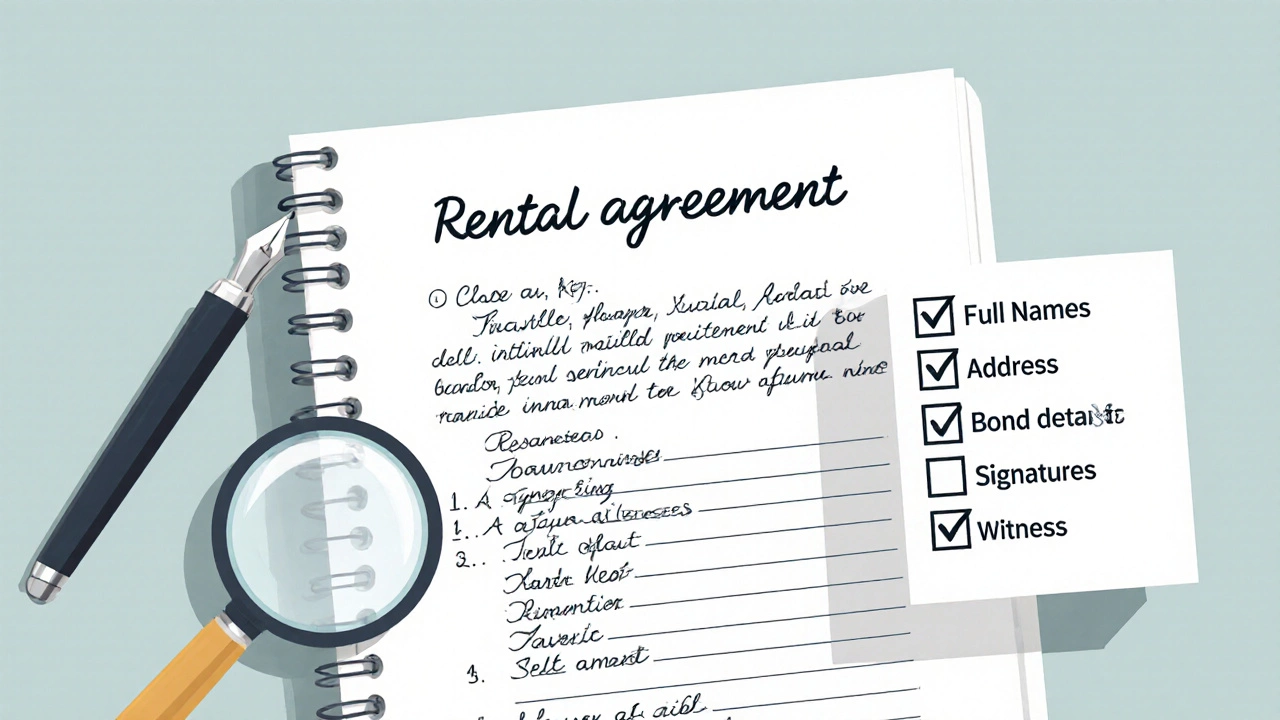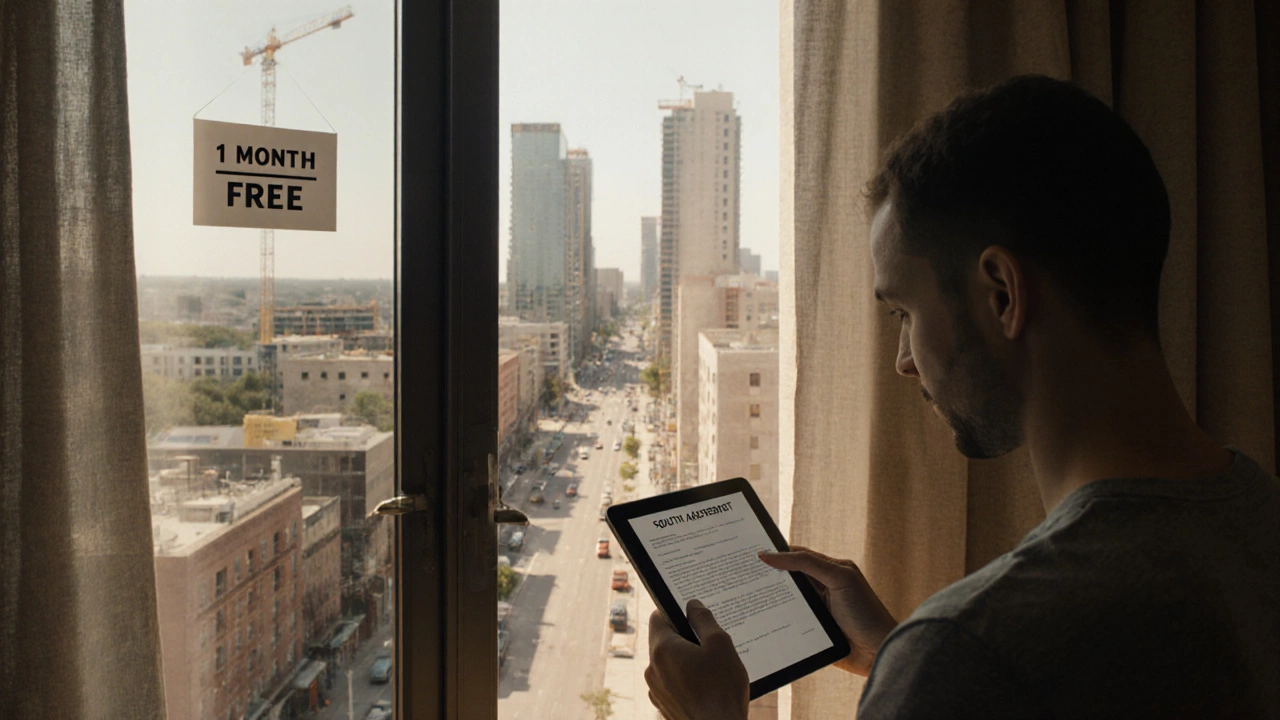Handwritten Lease Enforceability Checker
Check if Your Handwritten Agreement Meets Legal Requirements
Enter your agreement details to determine if it's legally enforceable under Australian tenancy laws.
Select all items present in your agreement:
Check your agreement
Click the button to check if your handwritten lease meets legal requirements.
When you’re moving into a new place, the first thing that pops up is the lease. But what if the landlord hands you a piece of paper scribbled in pen? handwritten agreement might sound informal, yet many Australians wonder if it holds up in court. This guide breaks down the law, the must‑have elements, and the common pitfalls so you can decide whether a handwritten rental contract is safe to sign.
What Exactly Is a Handwritten Agreement?
Handwritten Agreement is a contract that is written and signed by hand, rather than typed or generated electronically. It includes all the essential terms of the deal-rent amount, lease period, responsibilities-recorded in ink on paper. The physical form does not automatically make it any less binding, provided it meets the legal requirements for a contract.
Core Elements of a Valid Contract in Australia
Australian contract law follows a few timeless rules. A contract, handwritten or not, must satisfy four criteria:
- Offer - one party clearly proposes terms.
- Acceptance - the other party agrees without changes.
- Consideration - something of value is exchanged (usually rent for the right to occupy).
- Intention to create legal relations - both parties intend the document to be enforceable.
If any of these elements are missing, a court may deem the agreement void.
Statute of Frauds and the Need for Written Form
The Statute of Frauds is a collection of statutes that require certain contracts to be in writing to be enforceable. In most Australian states, residential leases longer than three years fall under this rule. However, for typical 6‑ or 12‑month rentals, the law does not demand a typed document; a handwritten note that clearly outlines the terms can satisfy the “written” requirement.
Specific Laws Governing Residential Leases
Each state has its own tenancy legislation. Below are the key points for the most populated states:
- NSW Residential Tenancies Act 2010 - Requires a written agreement for all residential tenancies, but does not prescribe the format. Handwritten contracts are acceptable if they contain all mandatory clauses.
- VIC Residential Tenancies Act 1997 - Similar stance; the agreement must be in writing and signed by both parties.
- QLD Residential Tenancies and Rooming Accommodation Act 2008 - Allows handwritten agreements, provided they are signed and dated.
Landlords who skip the required clauses (like bond handling, repair obligations, or termination notice periods) risk the entire agreement being voidable.

When a Handwritten Rental Agreement Is Acceptable
In practice, a handwritten lease works fine if it includes:
- Full names and contact details of landlord and tenant.
- Exact address of the rental property.
- Rent amount, frequency, and method of payment.
- Start and end dates of the tenancy.
- Bond amount and details of where it will be lodged.
- Clear clauses on repairs, utilities, and sub‑letting.
- Signatures of both parties, with dates.
- Witness signature (optional but strengthens enforceability).
Missing any of these could give the other side a reason to challenge the contract in a tribunal.
How to Strengthen a Handwritten Agreement
Even though a simple pen‑on‑paper note can be valid, you can boost its credibility:
- Use clear, legible handwriting. Illegible text may be disputed.
- Number each clause - this makes referencing easier during disputes.
- Include a disclaimer that both parties have read and understood every clause.
- Have an independent Witness sign and date the document. The witness does not need to be a lawyer; a friend or neighbour works.
- Make a photocopy or scan for both parties and keep the original in a safe place.
- If possible, register the agreement with the state’s tenancy authority (some jurisdictions allow lodging).
Risks of Relying Solely on Handwritten Contracts
While they are legal, handwritten leases carry a few drawbacks:
- Legibility issues - Courts may find it hard to interpret smudged or rushed writing.
- Difficulty updating - Adding a new clause often requires striking out text and re‑signing.
- Limited forensic evidence - Digital versions can be timestamped; paper cannot.
- Potential for missing statutory clauses - Landlords unfamiliar with the law may omit required terms.
These risks can be mitigated by converting the handwritten document into a typed copy after both parties agree, then attaching the original signatures as an appendix.
Handwritten vs. Typed vs. E‑Signature: Quick Comparison
| Feature | Handwritten | Typed (Word/Print) | E‑Signature |
|---|---|---|---|
| Legality (Australia) | Valid if essential clauses & signatures present | Valid; easier to ensure compliance | Valid under Electronic Transactions Act 1999 |
| Clarity | Depends on handwriting legibility | Clear and searchable | Clear; audit trail of signing time |
| Amendments | Requires crossing out & re‑signing | Simple edit & re‑sign | Version control built‑in |
| Proof of Date | Rely on dated signatures | Can include auto‑date fields | Timestamped automatically |
| Risk of Missing Clauses | Higher if landlord not law‑aware | Lower - can use standard templates | Lowest - platforms enforce required fields |

Checklist: Is Your Handwritten Rental Agreement Enforceable?
- All parties’ full legal names are spelled correctly.
- Property address is exact, including unit number.
- Rent amount, due date, and payment method are clearly stated.
- Lease term (start and end dates) is defined.
- Bond amount and lodgement details are included.
- Mandatory clauses from the relevant state act are present (e.g., notice periods, repair obligations).
- Both landlord and tenant have signed and dated the document.
- Optional: A neutral witness has signed and dated.
- A clear copy is stored by both parties; originals kept safe.
What to Do If You Receive a Handwritten Lease and Have Concerns
Don’t sign straight away. Follow these steps:
- Read every line. Highlight any vague or missing information.
- Compare the document with a standard template from your state’s tenancy authority.
- Ask the landlord to add any omitted mandatory clauses.
- If you’re still unsure, consult a tenancy lawyer or a community legal centre - many offer free advice for tenants.
- Consider asking for a typed copy after the landlord signs the handwritten version. Both signatures can be attached as an annex.
Real‑World Example: Sydney Flat Rental
Maria moved into a one‑bedroom flat in Sydney. The landlord handed her a two‑page handwritten agreement. It listed rent, bond, and the 12‑month term, but omitted the clause about the landlord’s obligation to maintain heating. Maria asked for the missing clause to be added. The landlord complied, and both signed again. Six months later, the heating broke down. Because the agreement now contained the maintenance clause, Maria successfully claimed a repair, and the tribunal ordered the landlord to fix it within 7 days.
This story shows that a handwritten lease can work, but only if it includes every required term.
Frequently Asked Questions
Can a handwritten rental agreement be used as evidence in a tribunal?
Yes. As long as the document is signed, dated, and contains all mandatory clauses, a tribunal will treat it as a valid contract. The key is that both parties can prove they signed it voluntarily.
Do I need a witness for my handwritten lease?
A witness isn’t required by law, but having one adds an extra layer of protection. If a dispute arises, the witness can confirm the signatures are genuine.
What happens if a handwritten lease is missing a required clause?
If a mandatory clause (like bond handling or notice period) is absent, the tribunal may deem that part of the agreement void. The rest of the lease can still be enforceable, but the missing element could be decided according to the default rules in the relevant act.
Is an electronic signature as strong as a handwritten one for rentals?
Under the Electronic Transactions Act 1999, e‑signatures are legally equivalent to handwritten signatures, provided the platform ensures the signer's identity and record integrity. Many tenants now prefer e‑sign platforms for the audit trail they provide.
Can I convert my handwritten lease into a typed document after signing?
Absolutely. Transcribe the exact wording, attach a scanned copy of the original handwritten signatures as an appendix, and have both parties initial each page of the typed version. This creates a clear, searchable record while preserving the original proof of agreement.





